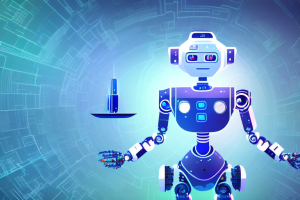Digital Twin Technology (DTT) is an emerging idea which merges physical assets with their virtual equivalents in order to allow businesses to effectively monitor and manage both types of assets simultaneously. Utilizing sensors connected via IoT as well as machine-learning algorithms, DTT allows organizations to collect analysis, simulate environments and simulate real world situations – helping improve operations efficiency while decreasing maintenance costs and streamlining design/creation process.
Understanding Digital Twin Technology
Definition and Concept
Digital Twin Technology involves developing an electronic representation of physical assets or systems to capture real-time information that changes as physical assets or systems shift over time. Digital Twins allow users to monitor this change over time in real-time and identify patterns which could compromise or enhance its performance at every point during its lifespan.
An electronic replica of a wind generator could be created and utilized to collect real-time information like wind speed, temperature and output power output. Such a digital twin could help identify when maintenance will need to be conducted while also improving turbine performance to boost energy production.
Key Components of Digital Twin Technology
Digital Twin Technology’s primary components include physical assets or systems, Internet of Things sensors and machine learning algorithms. Assets or systems produce real time data which is collected via IoT sensors before being processed by machine-learning algorithms that analyze it to provide insights on performance analysis of systems or assets as a whole; identify trends with crucial significance before optimizing operations further.
Sensors play an essential part of IoT technology by gathering real-time information of physical objects or systems. Sensors may be embedded directly within an asset itself or external sensors nearby which record its temperature or pressure readings as well as vibration levels and location based on which equipment or system needs examining.
Machine learning algorithms can be utilized to analyze IoT sensor data. They are capable of recognizing patterns, anomalies and trends within it which help enhance equipment or system efficiency and predict maintenance needs to reduce downtime while also prolonging lifespan of systems or assets.
Digital Twin Technology has witnessed incredible advancement over the past decade. Once used to model and improve complex systems such as oil pipelines, aircraft engines or manufacturing facilities; thanks to advances in IoT and machine learning they now serve to better personal assets such as automobiles as well as medical devices that improve people’s wellbeing and overall health.
Digital twins, for instance, can be developed specifically for use with medical devices like insulin pumps and pacemakers to record live performance data about these devices and enhance settings to make sure they function more effectively. Digital twins may also be employed to track patient health by recording data such as their blood pressure, heart rate and oxygen levels and then analyzing this information to discover patterns or trends which help physicians more accurately diagnose and treat illnesses more efficiently.
Digital Twin Technology provides users with an effective tool that enables them to keep an eye on physical systems and assets in real-time, identify problems or patterns, and use this data to enhance asset efficiency throughout its lifespan. As technology like IoT and machine-learning evolve, digital twin technologies continue to rapidly advance; being used both individually as well as collectively improve assets as well as people’s health – it will be exciting to watch how Digital Twin evolves further over time!

Discover the world of Digital Twin Technology with our comprehensive guide.
How Digital Twin Technology Operates
Digital Twin Technology is an efficient business tool used by organizations to build virtual copies of physical equipment or systems for tracking performance improvement purposes as well as troubleshooting issues or forecasting the future direction. Take a deeper dive into its workings.
Create a Digital Twin
The process of developing a digital twin involves three primary actions: data acquisition, modeling and simulation. Data collection uses sensors to gather information that is then processed through machine learning algorithms to build an electronic representation of an asset using that information gathered. Once built and then simulated by its digital twin, its performance is then replicated live while being compared against past data and forecasted into its future path.
Starting a digital twin requires gathering data. IoT sensors capture temperatures, pressure and vibration data that’s then uploaded into cloud storage for analysis by machine learning algorithms to provide insight into asset performance and provide insights for its future performance. Companies using data analysis for digital twin creation can then recognize patterns within assets’ performances that indicate where any issues lie allowing for problem resolution as well as anticipating its performance for planning purposes in the near future.
Once data have been compiled and analysed, modeling begins. Machine learning algorithms are utilized to build virtual representations of actual assets from information gathered through sensors; then this model can be utilized for real time asset performance predictions.
Step three is simulating. Businesses can utilize digital twins to accurately simulate an asset’s real-time performance and compare this information against previous records or predict future ones, helping maximize efficiency while solving potential issues and decreasing downtime risk.
Data Collection and Analysis Digital Twin Technology relies heavily on data collection from IoT sensors that transmit their collected information directly into the cloud where machine learning algorithms process it into meaningful insights about physical asset performance. Data analysis allows businesses to spot patterns, identify problems, and anticipate future performance of assets.
Sensor data is utilized by businesses to track physical assets such as manufacturing equipment, buildings and entire cities in real time – including manufacturing equipment, buildings and cities themselves. By monitoring this asset portfolio in real-time businesses can improve efficiency by decreasing downtime while speeding product development processes and creating innovative new offerings for sale.
Real-Time Monitoring and Updates One of the main advantages of Digital Twin Technology is real-time asset condition monitoring. Companies using it to track physical assets can identify issues before they arise and optimize performance by eliminating downtime altogether. Furthermore, updates can be immediately made to digital replica to reflect accurate depictions of physical asset.
Real-time updates and monitoring is especially advantageous to manufacturing facilities, enabling businesses to identify problems before they impede performance, reduce downtime, or cause major headaches.
Digital Twin Technology integrates IoT and AI for greater efficacy, reduced downtime and an streamlined design process. By collecting real-time information from physical objects via IoT devices and then processing that information using machine-learning algorithms, companies are able to maximize efficiency, reduce downtime and enhance design processes.
Digital Twin Technology combined with IoT and AI is an extremely effective means of revolutionizing various industries from healthcare to manufacturing. Through creating virtual copies of physical systems and assets that companies are able to enhance efficiency while decreasing costs and increasing profitability.
Digital Twin Technology has grown increasingly popular over time for good reason. Companies can utilize Digital Twin technology to make virtual replicas of physical assets – for instance a machine or an entire building – and utilize this virtual representation for various uses. Here we explore some key benefits from using this approach to virtualization.
Digital Twin Technology’s main advantage lies in its capacity to speed up product design and development. By creating virtual representations of their products, businesses are able to test it within virtual spaces before building it physically – this helps refine designs while decreasing cost and prototyping requirements – ultimately saving both time and energy while meeting customers’ requirements for their goods and services.
Auto manufacturers could utilize Digital Twin Technology to simulate the performance of their new engine before building tangible prototypes – this enables them to identify any issues early and adjust designs before incurring development expenses for this step. Doing this may save them thousands while guaranteeing high quality products!
Improved Operational Efficiency
Digital Twin Technology can enhance operational efficiency by enabling organizations to monitor and assess tangible assets in real time for greater operational efficiencies. Through creating digital copies of physical assets like machines or buildings, businesses are able to monitor efficiency levels over time and identify areas for potential improvement – helping reduce downtime for maintenance services while conserving resources while decreasing unscheduled delays due to maintenance needs.
Example of Digital Twin Technology use within manufacturing: it enables manufacturers to utilize this innovative tool to monitor the operation of their equipment. With Digital Twin technology in place, issues can be detected early enough and remedial actions taken immediately before becoming more serious, saving business hundreds in maintenance fees while guaranteeing their machines operate at optimal performance levels.
Predictive Maintenance and Decreased Downtime
Digital Twin’s predictive capabilities for maintenance enable companies to proactively detect issues earlier, thus avoiding unscheduled downtime, while simultaneously cutting maintenance costs. By simulating an asset’s performance in virtual settings companies are able to identify possible problems before they arise – thus cutting maintenance costs while improving uptime for clients.
One company may use Digital Twin Technology to monitor its plane engines’ performance, and identify any possible issues before failure occurs – which will save millions in operational expenses and ensure aircrafts continue running safely and smoothly.
Digital Twin Technology allows companies to maximize the performance of physical assets throughout their lifespans, using digital representations of assets as tools for tracking performance and making adjustments that ensure maximum functionality of these physical assets. By keeping an eye on a virtual representation of an asset’s performance and looking at areas for improvements that could lengthen its life while cutting maintenance costs down further and guaranteeing full utilization by its owner(s).
Property administrators may employ Digital Twin Technology to track the efficiency of an HVAC system and identify areas where efficiency improvements could be implemented, such as changing temperature or airflow settings. This approach could save hundreds of dollars on energy expenses while simultaneously making space comfortable and ensuring its occupants’ wellbeing.
Digital Twin Technology holds great promise for businesses across various fields. By creating digital replicas from actual assets, businesses can improve designs, develop products and enhance operations efficiency while decreasing downtime and optimizing efficiency of assets – and as technology develops further applications could expand as will their benefits over time.
Applications and Use Cases (APCUS)
Digital Twin Technology has grown increasingly popular within the manufacturing sector. Companies use it to simulate and improve their manufacturing lines to reduce costs while improving efficiency, as well as detect any potential production-related problems in advance and stop them before they arise.
Smart Cities and Infrastructure
Digital Twin Technology is being employed to design and improve smart city infrastructures that allow them to observe traffic flow as well as energy consumption and garbage management more accurately, leading to reduced energy use, less garbage accumulation, and improved quality of life for their citizens. By optimizing this smart infrastructure of cities they will be able to cut their energy use drastically while eliminating excess garbage while improving quality of life for citizens.
Healthcare and Medical Devices
Digital Twin Technology is being employed by health professionals to simulate and optimize medical devices used by their patients, which allows for enhanced patient outcomes. By creating digital replicas of devices used by individuals they can track its performance at any time and spot potential problems before taking preventive steps if required.
Energy and Utilities
Digital Twin Technology is being utilized by companies to analyze and optimize utility and energy resources, making it possible to streamline operations while cutting expenses. By simulating property performance, companies will be able to detect problems early and optimize operations thereby decreasing downtime while increasing productivity.
Digital Twin Technology is an emerging field that is revolutionizing how companies manage and optimize tangible assets. Through creating virtual models of physical assets, businesses are able to track performance in real time while decreasing maintenance time while improving operational efficiencies and saving costs in both maintenance and operations. Used across industries from manufacturing to smart cities and healthcare as well as energy sectors; Digital Twin technology is revolutionising how people connect to physical reality.



